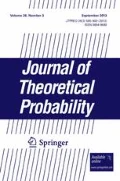Abstract
A collection of items (e.g., books), each with an associated weight (or popularity), is arranged in a row. At each unit of time an item is removed with probability proportional to its weight and replaced at the left end of the row. Thismove-to-front rule gives a Markov chain on permutations often known as theTsetlin library. We derive an exact and tractable formula for the probability of any permutation after any number of moves. From the formula we read off previously studied quantities of interest associated with the chain, such as the stationary distribution and eigenvalues. Measuring discrepancy from stationarity by separation, we use the formula to find the initial arrangement giving the slowest convergence to stationarity. The time to stationarity in this case is a convolution of geometric random variables which we analyze for three natural choices of weights. We also assess the time required for an important functional, namely, expected search cost, to approach its stationary value.
Similar content being viewed by others
References
Aldous, D., and Diaconis, P. (1986). Shuffling cards and stopping times.Amer. Math. Monthly 93, 333–348.
Aldous, D., and Diaconis, P. (1987). Strong uniform times and finite random walks.Advances in Appl. Math. 8, 69–97.
Bentley, J. L., and McGeoch, C. C. (1985). Amortized analyses of self-organizing sequential search heuristics,Comm. ACM 28, 404–411.
Bentley, J. L., Sleator, D. D., Tarjan, R. E., and Wei, V. K. (1986). A locally adaptive data compression scheme.Comm. ACM 29, 320–330.
Bitner, J. R. (1979). Heuristics that dynamically organize data structures.SIAM J. Comput. 8, 82–110.
Björner, A. (1984). Orderings of Coxeter groups, in Combinatorics and Algebra, Amer. Math. Soc., Providence, Rhode Island,Contemporary Math. 34, 175–195.
Burville, P. J. (1974). Heaps: a concept in optimization.J. Inst. Math. Applic. 13, 263–278.
Burville, P. J., and Kingman, J. F. C. (1973). On a model for storage and search.J. Appl. Prob. 10, 697–701.
Diaconis, P. (1993). Analysis of some weighted mixing schemes (unpublished manuscript).
Diaconis, P., and Fill, J. A. (1990). Strong stationary times via a new form of duality.Ann. Prob. 18, 1483–1522.
Diaconis, P., Fill, J. A., and Pitman, J. (1992). Analysis of top to random shuffles.Comb. Prob. and Comp. 1, 135–155.
Donnelly, P. (1991). The heaps process, libraries and size-biased permutations.J. Appl. Prob. 28, 321–335.
Feller, W. (1968).An Introduction to Probability Theory and its Applications. Vol. 1, 3rd ed., Wiley, New York.
Gonnet, G. H., Munro, J. I., and Suwanda, H. (1981). Exegesis of self-organizing linear search.SIAM J. Comput. 3, 613–637.
Hendricks, W. J. (1972). The stationary distribution of an interesting Markov chain.J. Appl. Prob. 9, 231–233.
Hendricks, W. J. (1976). An account of self-organizing systems.SIAM J. Comput. 5, 715–723.
Hendricks, W. J. (1989). Self-organizing Markov chains. MITRE Corporation, McLean, Virginia.
Hester, J. H., and Hirschberg, D. S. (1985). Self-organizing linear search.ACM Comp. Surveys 19, 295–311.
Kan, Y. C., and Ross, S. M. (1980). Optimal list order under partial memory constraints.J. Appl. Prob. 17, 1004–1015.
Kapoor, S., and Reingold, E. (1991). Stochastic rearrangement rules for self-organizing data structures.Algorithmica 6, 278–291.
Kingman, J. F. C. (1975). Random discrete distributions.J. R. Statist. Soc. B 37, 1–22.
Lam, K., Leung, M. Y., and Siu, M. K. (1984). Self-organizing files with dependent accesses.J. Appl. Prob. 21, 343–359.
Lelewer, D. A., and Hirschberg, D. S. (1987). Self-organizing linear search.ACM Computing Surveys 19, 261–296.
Letac, G. (1974). Transience and recurrence of an interesting Markov chain.J. Appl. Prob. 11, 818–824.
McCabe, J. (1965). On serial files with relocatable records.Oper. Res. 13, 609–618.
Phatarfod, R. M. (1991). On the matrix occurring in a linear search problem.J. Appl. Prob. 28, 336–346.
Phatarfod, R. M. (1994). On the transition probabilities of move to the front scheme.J. Appl. Prob. 31, 570–574.
Rivest, R. (1976). On self-organizing sequential search heuristics.Comm. ACM 19, 63–66.
Sleator, D. D., and Tarjan, R. E. (1985a). Amortized efficiency of list update and paging rules.Comm. ACM 28, 202–208.
Sleator, D. D., and Tarjan, R. E. (1985b). Self-adjusting binary search trees.J. ACM 32, 652–686.
Topkis, D. M. (1986). Reordering heuristics for routing in communications networks.J. Appl. Prob. 23, 130–143.
Tsetlin, M. L. (1963). Finite automata and models of simple forms of behavior.Russian Math. Surv. 18(4), 1–27.
Author information
Authors and Affiliations
Rights and permissions
About this article
Cite this article
Fill, J.A. An exact formula for the move-to-front rule for self-organizing lists. J Theor Probab 9, 113–160 (1996). https://doi.org/10.1007/BF02213737
Received:
Issue Date:
DOI: https://doi.org/10.1007/BF02213737




